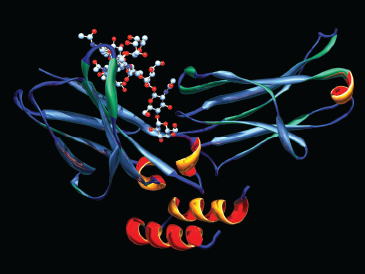
Rituximab drug molecule
Pulmonary arterial hypertension (PAH) in connective tissue disease (CTD) features significant morbidity and mortality. Standard therapies with endothelin receptor antagonists and phosphodiesterase-5 inhibitors have shown some clinical improvement in patients, but these clinical improvements have proved modest when compared with other types of PAH. As our case below suggests, rituximab may show promise as a primary therapy in PAH associated with CTD.
Case Presentation
A 29-year-old Asian female with a history of mixed connective tissue disorder (MCTD) presented to our clinic with dyspnea. She was diagnosed at the age of 2, and her disease manifestations included sclerodactyly, facial tightness and mild myositis. She had an anti-nuclear antibody (ANA) titer of 1:2560 and a ribonucleoprotein (RNP) result greater than 100. She was negative for double-stranded DNA (dsDNA), anti-Smith, anti-Ro/SSA and anti-La/SSB antibodies. She was on a standing immunosuppressive regimen of mycophenolate mofetil 1 g twice a day, hydroxychloroquine 200 mg twice a day and prednisone doses ranging from 1 mg daily up to 40 mg daily depending on disease activity.
Due to her dyspnea in the setting of MCTD, a transthoracic echocardiogram was obtained. It demonstrated severe pulmonary hypertension (PASP 85) with a dilated hypertrophied right ventricle and moderately reduced right ventricular systolic function. Her six-minute walk test (6MWT) demonstrated an ambulation of 1,570 feet on room air with a corresponding modified Borg dyspnea score of 5. A right heart catheterization was obtained and showed a right ventricle systolic pressure of 74 mmHg, a right ventricle diastolic pressure of 10, a pulmonary capillary wedge pressure of 10 and a pulmonary artery mean pressure of 51. A pulmonary angiography was negative for chronic or acute thrombopulmonary embolus. She was classified with PAH class IIIA and eventually started on ambrisentan.
A repeat transthoracic echocardiogram one year later demonstrated an estimated pulmonary arterial systolic pressure of 72 mmHg and moderate to severe reduction in right ventricular systolic function. Her 6MWT and Borg dyspnea scores remained the same. Thereafter, she was lost to follow-up with pulmonology for about a year. She continued to see a rheumatologist during this period, and she was started on rituximab infusions for severe thrombocytopenia and vasculopathic lesions on her toes with no other major changes made to her medication regimen.
She reestablished care with pulmonology three months after starting rituximab infusions and reported significant improvement in her dyspnea. At that time, a transthoracic echo showed a normal right ventricular systolic function and insufficient tricuspid regurgitation to estimate either the right ventricular systolic pressure or her pulmonary artery pressure. Her 6MWT improved to 1,640 feet with a Borg dyspnea score of 3.
Discussion
PAH in CTD is a rare complication occurring in 0.5–14% of patients.1 Several studies have shown that in patients with PAH secondary to systemic lupus erythematosus (SLE), the two-year mortality rate can run up to 50%.1
Compared with idiopathic pulmonary arterial hypertension, PAH associated with CTD occurs predominantly in older women and features progressive symptoms (e.g., dyspnea, chest pain, palpitations), leading to a shorter survival.2
The pathogenesis of PAH associated with CTD isn’t clearly understood. A study done by Quismorio et al proposed that the deposition of immune complexes within the pulmonary vascular endothelium results in dysfunction leading to PAH.3 Other investigators propose that PAH may develop secondary to direct proliferative vascular involvement associated with interstitial fibrosis and pulmonary venous hypertension due to left-side heart disease.4
Due to this theory, the use of immunosuppressants and steroids may prove more suitable for treatment compared with directed therapies with endothelin receptor antagonists and phosphodiesterase-5 inhibitors.4,5 Rituximab delivers significant immunomodulatory effects in autoimmune and hematologic pathologies. As our case suggests, rituximab may show promise as a primary therapy in the treatment of PAH-associated with CTD.
 Josna Haritha, MD, MPH, completed medical school at the University of Alabama in 2013 and finished an internal medicine residency at Virginia Commonwealth University (VCU) in 2016. She is a first-year rheumatology fellow at the University of Chicago.
Josna Haritha, MD, MPH, completed medical school at the University of Alabama in 2013 and finished an internal medicine residency at Virginia Commonwealth University (VCU) in 2016. She is a first-year rheumatology fellow at the University of Chicago.
 Huzaefah Syed, MD, joined the VCU faculty in 2012 as a rheumatology clinician-educator at the level of assistant professor. She completed all of her training at VCU School of Medicine and has a special interest in rheumatoid arthritis and sarcoidosis.
Huzaefah Syed, MD, joined the VCU faculty in 2012 as a rheumatology clinician-educator at the level of assistant professor. She completed all of her training at VCU School of Medicine and has a special interest in rheumatoid arthritis and sarcoidosis.
 Abhishek Nandan, MD, completed medical school at Michigan State University, finished an internal medicine residency at VCU in 2016 and is currently a second-year rheumatology fellow at VCU.
Abhishek Nandan, MD, completed medical school at Michigan State University, finished an internal medicine residency at VCU in 2016 and is currently a second-year rheumatology fellow at VCU.
 Daniel Grinnan, MD, is an associate professor in pulmonary and critical care at VCU and director of VCU’s comprehensive care center for pulmonary hypertension.
Daniel Grinnan, MD, is an associate professor in pulmonary and critical care at VCU and director of VCU’s comprehensive care center for pulmonary hypertension.
References
- Chung, SM, Lee CK, Lee EY, et al. Clinical aspects of pulmonary hypertension in patients with systemic lupus erythematosus and in patients with idiopathic pulmonary arterial hypertension. Clin Rheumatol. 2006 Nov;25(6):866–872.
- Galiè N, Manes A, Farahani KV, et al. Pulmonary arterial hypertension associated to connective tissue disease. Lupus. 2005;14(9):713–717.
- Quismorio FP Jr., Sharma O, Koss M, et al. Immunopathologic and clinical studies in pulmonary hypertension associated with systemic lupus erythematosus. Semin Arthritis Rheum. 1984 May;13(4):349–359.
- Denton CP, Pope JE, Peter HH, et al. Long-term effects of bosentan on quality of life, survival, safety and tolerability in pulmonary arterial hypertension related to connective tissue diseases. Ann Rheum Dis. 2008 Sep;67(9):1222–1228.
- Galiè N, Olschewski H, Oudiz RJ, et al. Ambrisentan for the treatment of pulmonary arterial hypertension: Results of the ambrisentan in pulmonary arterial hypertension, randomized, double-blind, placebo-controlled, multicenter, efficacy (ARIES) study 1 and 2. Circulation. 2008 June 10;117(23):3010–3019.
